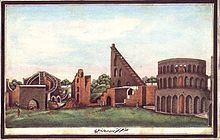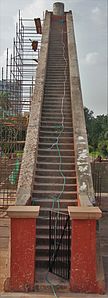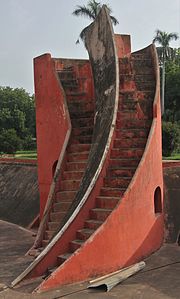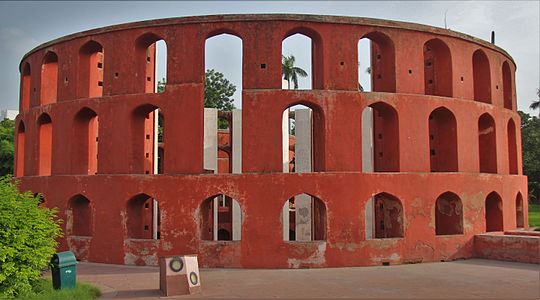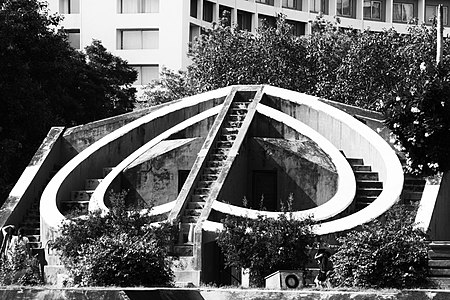Jantar Mantar (Delhi)
The Jantar Mantar (Hindi: जंतर मंतर) is a historic building in Delhi's New Delhi district , located on Parliament Street, which consists of several structures that were used for astronomical purposes. It was the first of five Jantar mantars that Maharaja Jai Singh II of Jaipur had built from 1723 onwards. Previously, 1710 was mistakenly assumed to be the year of the completion of the Jantar Mantar of Delhi; today, 1724 is generally considered to be the year of inauguration.
The purpose of the structures was to compile astronomical tables in order to be able to predict the movements and the times of appearance of the sun, moon and planets and thus create reliable calendars.
history
According to legends, the construction of the Jantar Mantar of Delhi goes back to a dispute between Hindu and Muslim astrologers, who were supposed to calculate the best time for a trip for the ruler Muhammad Shah in 1719. Jai Shing, who is following the dispute, concluded that the disagreement was due to incorrect tables of the position and movement of the stars. Accordingly, he sought permission from Muhammad Shah to correct these tables. The political reasons for this fall within the realm of astrology; In India at the time, the belief that the will of the gods or of God could be read from the stars and that an undertaking could be influenced by choosing the right time according to the stars was still widespread. The methods used to determine the position and movement of the celestial bodies, on the other hand, belong to the realm of astronomy.
At first Jai Singh tried to correct the tables using smaller traditional instruments, but quickly realized that their accuracy was insufficient for his purposes; In addition, it is said to have pursued the intention of avoiding the signs of wear and tear that occur with traditional, small instruments such as the astrolabes after prolonged use. He then studied Ulug Beg's observatory in Samarkand. Although the Jantar Mantar of Delhi in India was celebrated as an ingenious individual achievement of Jai Shing immediately after its completion in 1724, some of the instruments are strongly reminiscent of those made in Samarkand (Rama Yantra, Samar Yantra), but were larger. Jai Shing also asked some Jesuit priests for information on the state of astronomy in Europe. A big question is why Shing did not use telescopes to perform his task. Some voices claim that the Jesuit priests wanted to avoid the questions raised by the possibilities of the telescope at that time about the position of the planets and the movement of the earth, which were theologically highly charged, and perhaps simply kept silent about these modern developments. Others argue that Singh only learned of the possibilities of telescopes after he had announced his idea of a gigantic observatory and now refused to admit that smaller instruments could provide more accurate results.
When Jai Singh finally presented his results, he used both Afghan and European sources as well as some of his own measurements, some of which were also made with smaller instruments, others with the large instruments of the Jantar Mantar. In fact, the Jantar Mantar was only actively used by Delhi for a few years. The Jantar Mantas following the Jantar Mantar of Delhi, of which the largest in Jai Singh's newly created capital Jaipur, did not add anything fundamentally new to the astronomical observations and probably served to check the obtained values in other places and for astrological-sociocultural purposes. #
The Jantar Mantar of Delhi was badly damaged in the Indian Rebellion of 1857, but was later restored. Today the place is a pass park and also a tourist attraction.
In the 1990s, the Jantar Mantar area of New Delhi was widely used for demonstrations and civil protests; the government tried to prevent this with reference to the historical nature of the place.
Purpose of individual structures
- The Samrat Yantra (roughly: master instrument) is a kind of sundial. The hypotenuse of the triangular structure is parallel to the earth's axis; on both sides of the triangle there are markings for hours, minutes and seconds. Due to the dimensions of this sundial, quite precise measurements could be made here.
- The Jay Prakash Yantra (also Jayaprakash Yantra or Jai Prakash ) consists of hollow hemispheres with markings on the concave surfaces that could be assigned to the positions of the stars. For example, the height of the sun was determined. It is a significant further development of the ancient scaphe .
- The Misra Yantra was used to determine the longest and shortest day of the year; in addition, noon could be determined in various other cities.
- The Rama Yantra was used to determine the position of the sun and stars.
photos
Web links
Individual evidence
- ↑ http://delhitourism.gov.in/delhitourism/tourist_place/jantar_mantar.jsp
- ↑ http://wol.jw.org/en/wol/d/r1/lp-e/102005485
- ↑ Archived copy ( memento of the original from December 20, 2016 in the Internet Archive ) Info: The archive link was inserted automatically and has not yet been checked. Please check the original and archive link according to the instructions and then remove this notice.
- ↑ http://www.countercurrents.org/katyal220310.htm
Coordinates: 28 ° 37 ′ 37.9 ″ N , 77 ° 12 ′ 59.8 ″ E
